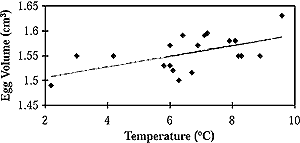5.4.2. Pressures on Wildlife
|

Figure 5-3: Change in egg volume of Pied Flycatcher
birds over time. Regression line is y = 1.24 + 0.004 x (P<0.01).

Figure 5-4: Change in the mean air temperature
during the egg laying time period of the Pied Flycatcher. Regression
line is y = -5.5 + 0.14 x (P<0.7).

Figure 5-5: Correlation between egg volume of the
Pied Flycatcher over the years and mean air temperature (regression
is significant at P<0.01).
|
Rapid climate change is only one of a long list of pressures
on wildlife. Alone or in combination, these pressures may greatly increase species'
vulnerabilities to rarity and extinction. Pressures such as land use and land-use
change, introduction of exotic species, pollution/poisoning, and extreme climatic
events and recent rapid climate change are of major concern and are discussed
below. Other pressures include wildlife diseases, human persecution (e.g., overharvest,
harassment), collisions with towers and other structures, collisions with cars
and other forms of transportation, electrocutions, anthropogenic barriers to
dispersal, war and other civil conflict, and wildlife trade (see Price et al.,
2000, for more information and references).
Conversion of natural and semi-natural habitats currently is quite extensive.
Although climate change is starting to have observable effects on wildlife and
the predicted future impact of climate change is expected to be large, the immediate
principal current threat to the world's wildlife is habitat conversion (Vitousek
et al., 1997a). Roughly 80% of forests that originally covered the Earth
have been cleared or degraded, and logging, mining, or other large-scale developments
threaten 39% of what remains (UNEP, 2000). Roughly 65% of Asia's wildlife habitat
has been converted to other uses, as well as nearly 75% of Australian rainforests
(UNEP, 2000). Habitat conversion and degradation affect nearly 89% of all threatened
birds and 83% of all threatened mammals (IUCN, 2000). Nearly 75% of all threatened
bird species are found in forests (Stattersfield et al., 1998), and tropical
forests are the most species-rich terrestrial habitats; an estimated 90% of
the world's species occur in moist tropical forests, which cover only 8% of
the land area (UNEP, 2000).
Introduction of exotic species, intentionally and accidentally, has
had deleterious effects on wildlife populations. Overall, 18% of threatened
mammals in Australia and the Americas and 20% of the world's birds are challenged
by introduced species (UNEP, 2000). Most extinctions on islands can be tied
to introduction of species that prey on native species or destroy critical habitats
(Stattersfield, et al., 1998).
Pollution and other biochemical poisonings have direct and indirect effects
on wildlife. Chemical contaminants have been detected in the tissues of species
from around the globe, in regions such as Brazilian Pantanal wetlands (Alho
Cleber and Vieira Luiz, 1997) and remote arctic habitats (UNEP, 2000). The most
obvious effects of chemicals are direct poisoning events. These frequently are
side effects of pesticide applications and can lead to losses of thousands of
individuals (Biber and Salathe, 1991). In addition to affecting wildlife directly,
contaminants can indirectly affect them by modifying their habitats.
Stochastic and extreme climatic events can cause deaths of large numbers
of individuals and contribute significantly to determining species composition
in ecosystems (Parmesan et al., 2000). Hurricanes can lead to direct mortality,
and their aftermath may cause declines because of loss of resources required
for foraging and breeding (Wiley and Wunderle, 1994). Many of these extreme
climatic events are cyclical in nature, such as sea surface temperature (SST)
changes that are associated with the El Niño-Southern Oscillation (ENSO).
Sea temperature increases associated with ENSO events have been implicated in
reproductive failure in seabirds (Wingfield et al., 1999), reduced survival
and reduced size in iguanas (Wikelski and Thom, 2000), and major shifts in island
food webs (Stapp et al., 1999). Extreme drought in Africa was thought to have
contributed to declines in the populations of many Palearctic migratory birds
that wintered in the savanna and steppe zones of the Sahel (Biber and Salathe,
1991).
Climate and climate change are strong drivers of biotic systems. The
distribution and survival of most species are moderated by climate (Root, 1988a,b,c;
Martin, 1998; Duellman,1999). Although species have responded to climatic changes
throughout evolutionary time (Harris, 1993), the primary concern today is the
projected rapid rate of change. High species richness appears to be related
to stable conditions; abrupt impoverishment of species has occurred during times
of rapid change (Tambussi et al., 1993).
Synergistic effects are likely to be quite damaging to animals. As habitat
becomes more fragmented, barriers to dispersal or expansions of species'
ranges could occur. This could force individuals to remain in inhospitable areas,
decreasing the range and population size of species and ultimately leading to
extinction (Rabinowitz, 1981). Fragmentation also may facilitate movement of
invasive species into an area, leading to potential population declines through
predation, competition, or transmission of disease (e.g., May and Norton, 1996).
Increasing urbanization also could lead to increasing exposure to contaminants,
which may make species less fit to survive changes in environmental conditions
or weaken their immune systems (Pounds and Crump, 1987; Berger et al., 1998).
Human responses to climate change also may contribute to synergistic effects;
for example, if new pest outbreaks are countered with increased pesticide use,
nontarget species might have to endure climate- and contaminant-linked stressors.
|